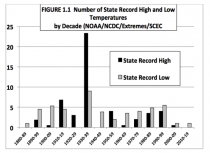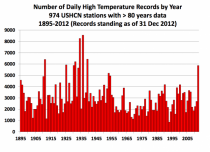By David Legates and Paul Driessen
ICECAP NOTE: See Paul’s book and many new entries in the Icecap Amazon Store. A lot of eye opening reading in the close to 90 books posted and available. Icecap gets a small percentage of the discounted prices to help us pay the bills and conduct the activities we do regionally and nationally in presentations, cable TV shows, interviews for TV and movies (coming soon) and in battling the EPA in the courts. As always your help with that and donations are always appreciated. The sad thing is that most all our efforts are pro bono while climate pretenders like Gore get $100,000 to do one presentation - no questions allowed and the alarmist spokesmen, professors and sites get thousands to millions in grants from the government (federal and state) and the Eco friendly funds.
The Department of Natural Resources and Environmental Control paid a professor from Texas named Dr. Katherine Hayhoe $46,000 to come up with a study on climate change and what was going to happen to Delaware if temperatures continued to rise and the oceans continued to flood the world. The state presumably wants people to think that “independent scholars” support the state’s positions.
The preliminary release of her report reads like the script from a bad disaster movie - think “The Day After Tomorrow” and “An Inconvenient Truth.”
It fails to mention the extreme cold that many places around the globe experienced recently. Europe and Russia in particular suffered through bitter cold the past two winters. The report likewise ignores that average global temperatures have not risen at all during the last 16 years; in fact, Earth has actually cooled slightly during the past decade.
For its really scary worst-case scenario, Dr. Hayhoe says Delaware’s temperatures will rise astronomically in coming decades: with more than two full months of endless days above 95 degrees Fahrenheit and a hundred-fold increase in days with temperatures at or above 100 degrees Fahrenheit by 2100. “Trends to more extreme highs and fewer extreme lows already are apparent,” Dr. Hayhoe asserts.
Data from 970 weather stations across the United States reveal that more record daily high air temperatures were set in the 1930s than in any recent decade, and no increase in frequency of higher temperatures has been observed since 1955. The Delaware State Climatologist examined New Castle County Airport records and found no long-term trend in either the total number of days or the number of consecutive days with maximum air temperature above 90 degrees Fahrenheit.
Globally, daytime high temperatures do not show significant warming - and most of the warming that has been observed is confined to nighttime low temperatures. Nighttime lows are driven by turbulence (or lack thereof) near the surface, not by the accumulation of energy related to CO2 warming of the deep atmosphere.
By contrast, maximum daily temperature is a measure of the energy content of the deep atmosphere, and is thus a much better measure of the warming due to greenhouse gases. The lack of a signal in maximum temperature suggests that the rate of warming due to CO2 is relatively small - and certainly much smaller than climate models suggest.
As for precipitation, Dr. Hayhoe claims that both floods and droughts will increase, with “more rain arriving as heavy downpours, and more dry periods in between.” This assertion was dispelled in a recent Intergovernmental Panel on Climate Change report on extreme events, released last summer.
The IPCC report concluded that “in some regions droughts have become less frequent, less intense or shorter; for example in central North America.” Similarly, the National Oceanographic and Atmospheric Administration has produced plots that show which parts of the United States are classified as moderate to extreme for dryness and wetness. While both conditions show considerable variability, neither exhibits a significant trend. NOAA also concludes that snowfall records show no long-term trend, and recent record snowfalls are the result of natural variability.
Why should Delaware’s or the nation’s future be any different than the past 50 years of increasing carbon dioxide concentrations? Dr. Hayhoe bases her extreme scenarios on climate models - the same models that have predicted major temperature trends that haven’t materialized; greatly exaggerated short-term trends in rainfall, droughts and violent storms; and failed to predict the lack of warming since 1998. Why should we believe them now?
Paul Driessen is senior policy analyst for the Committee For A Constructive Tomorrow (CFACT) and author of “Eco-Imperialism: Green power, black death” (Merril Press, 2012). David Legates is a professor of climatology at the University of Delaware and has studied climatology for more than 30 years. He is an adviser to the Caesar Rodney Institute.






